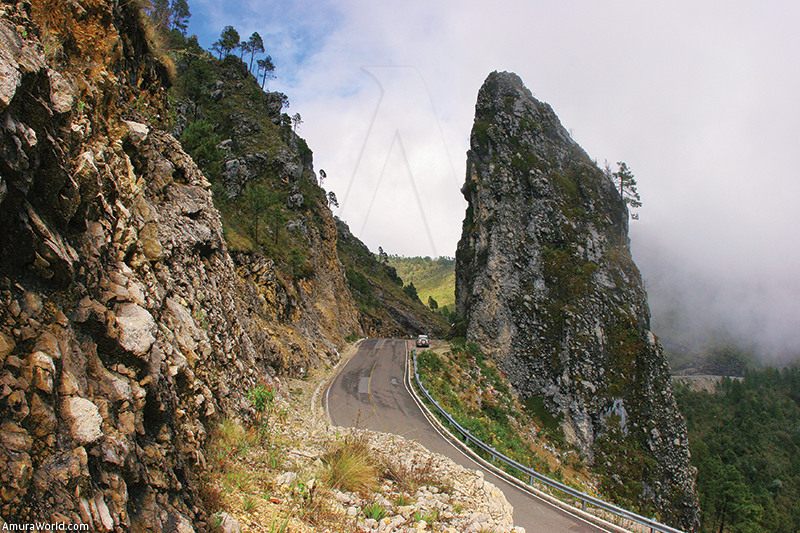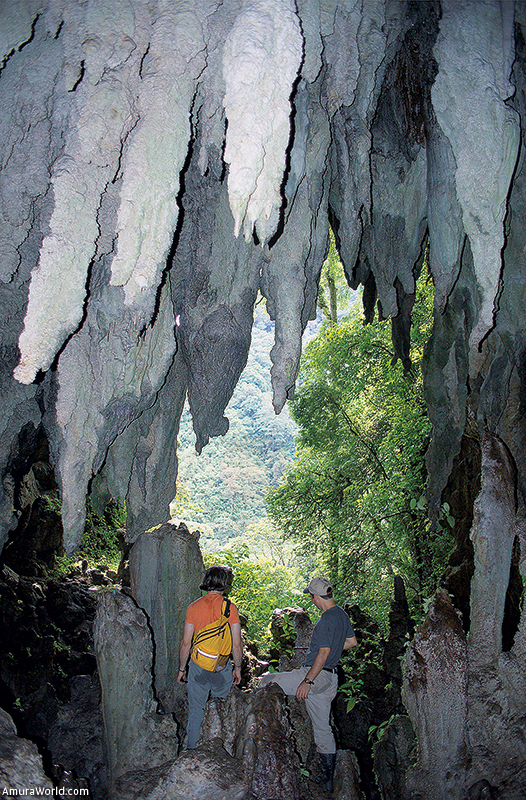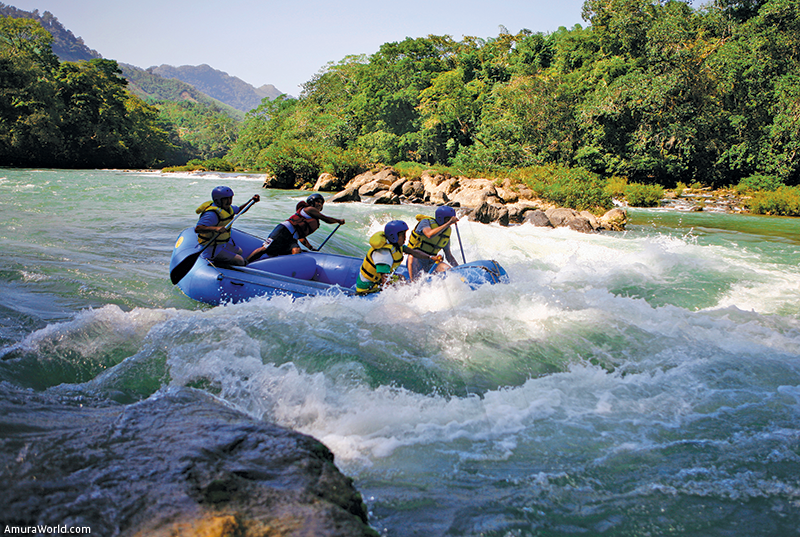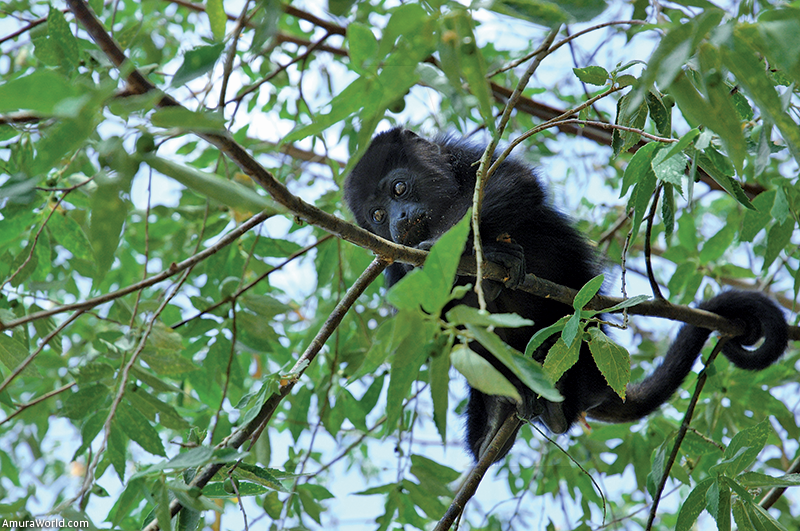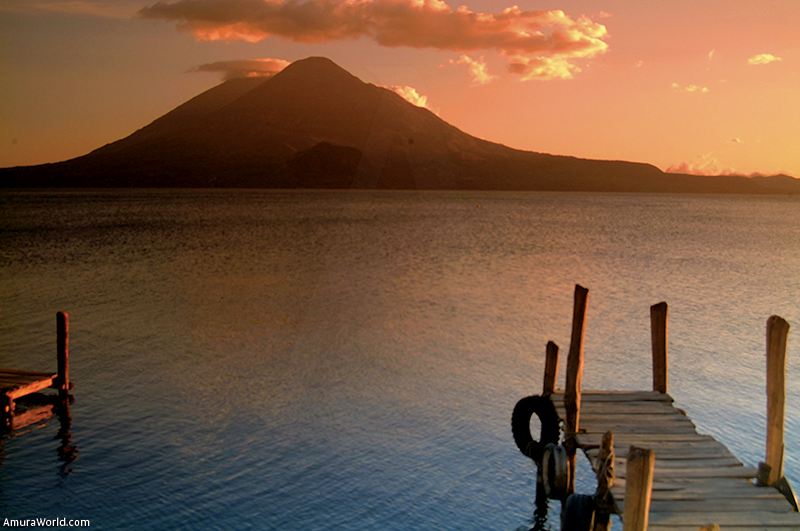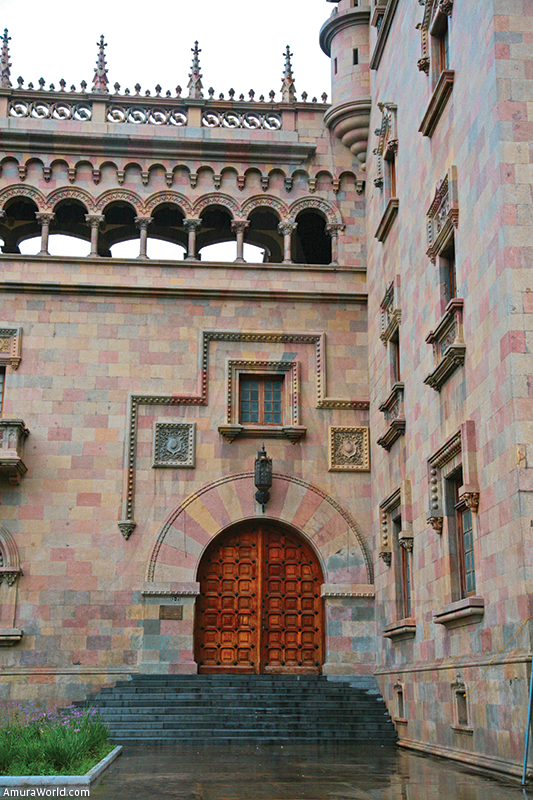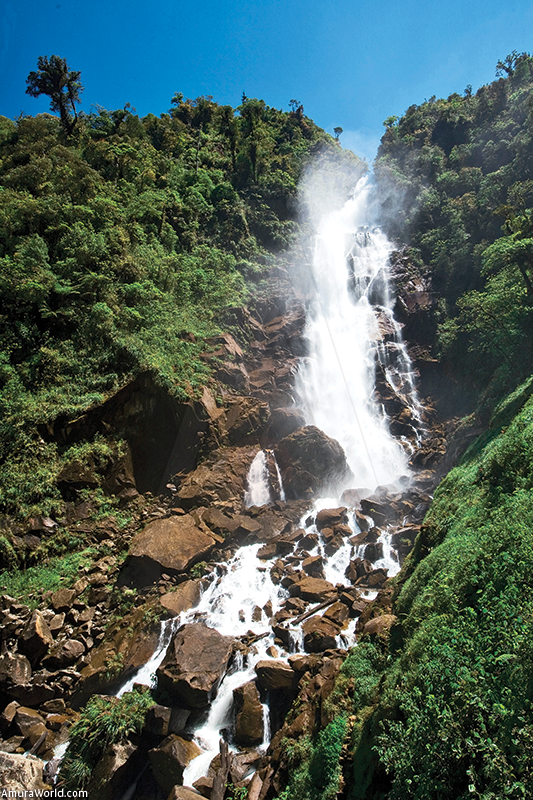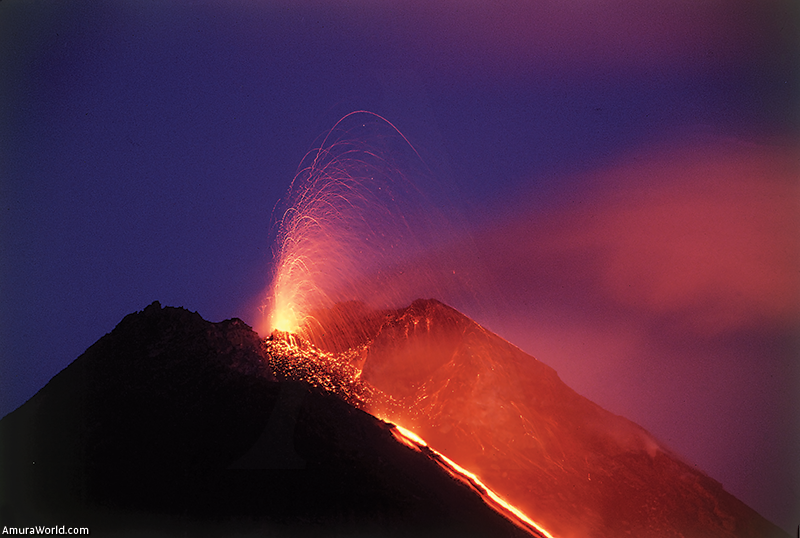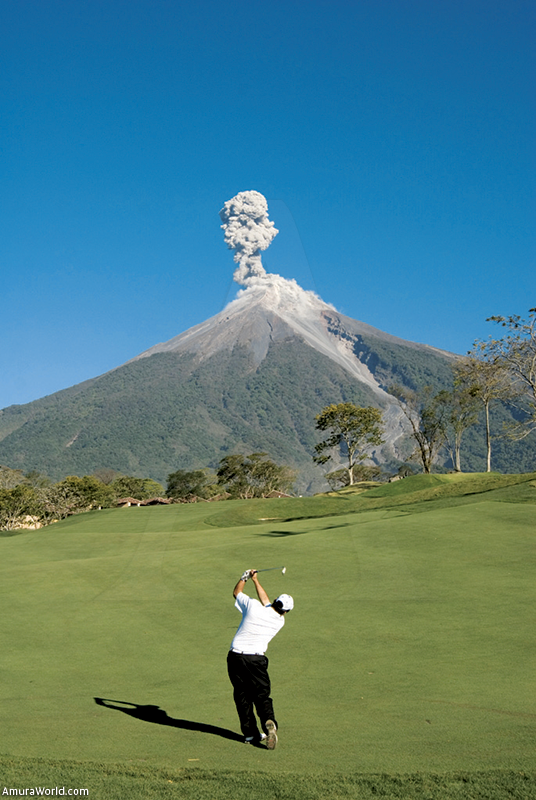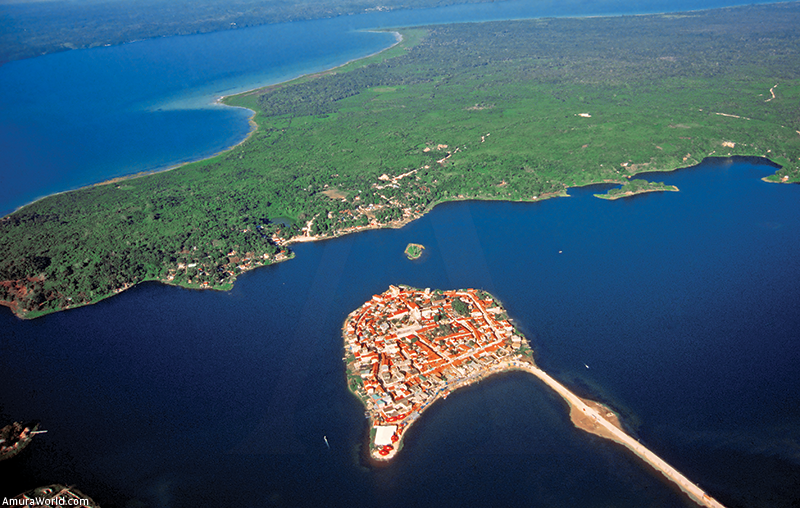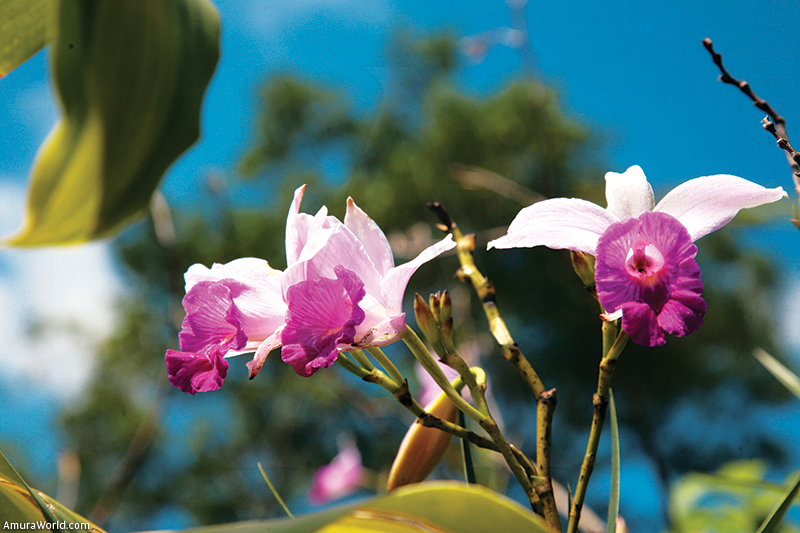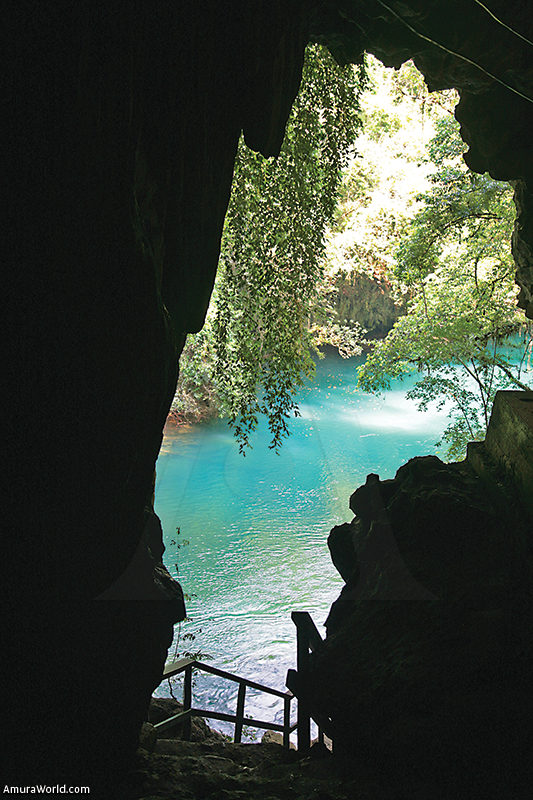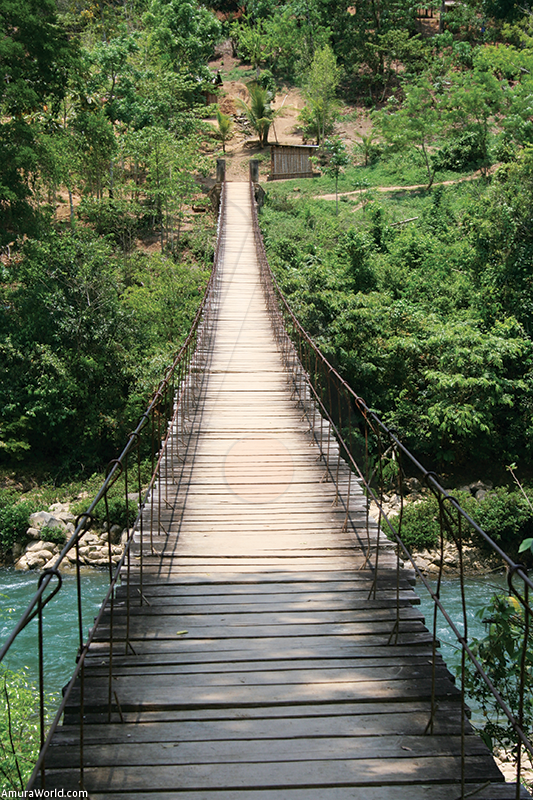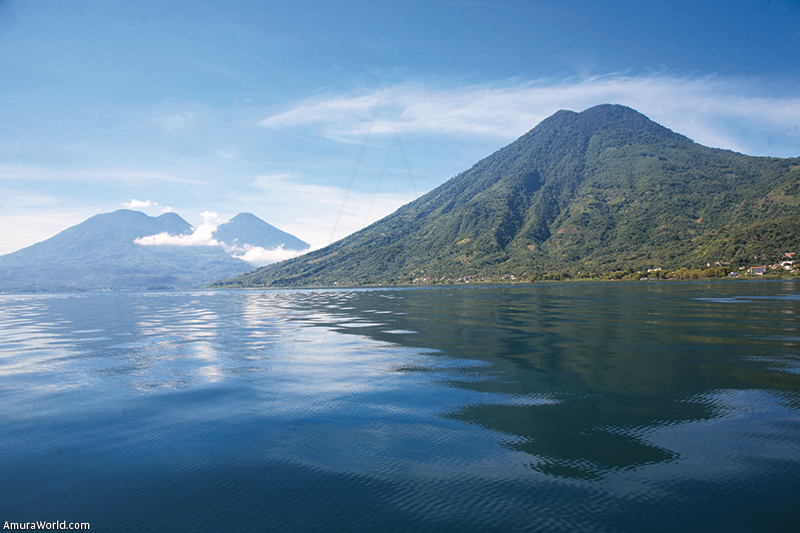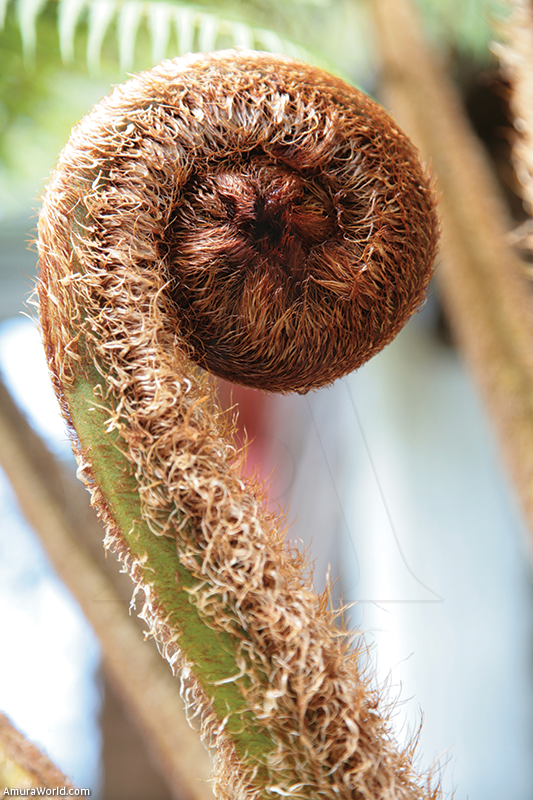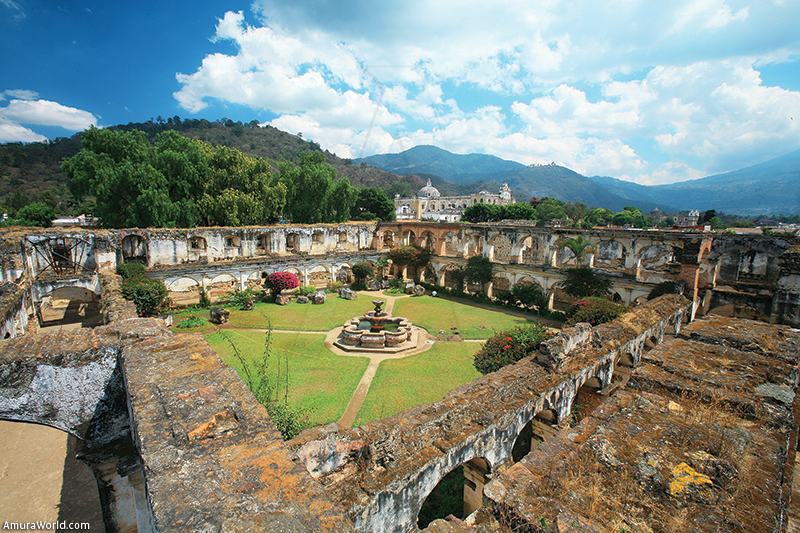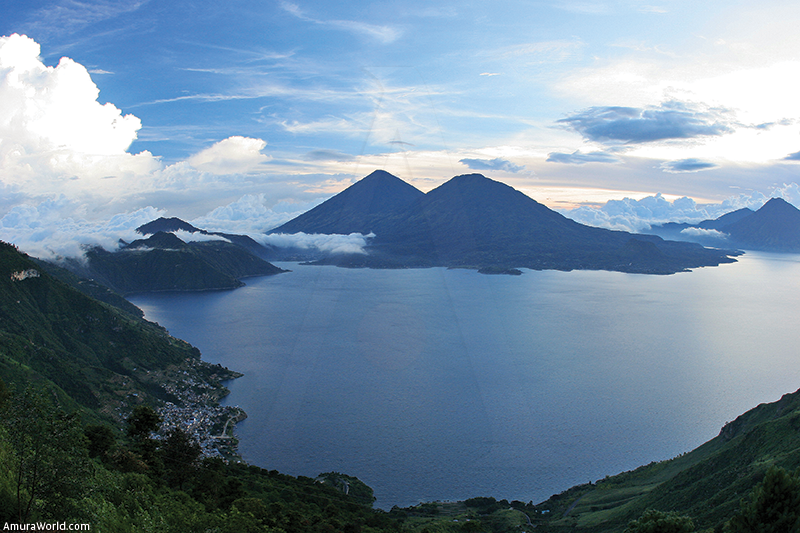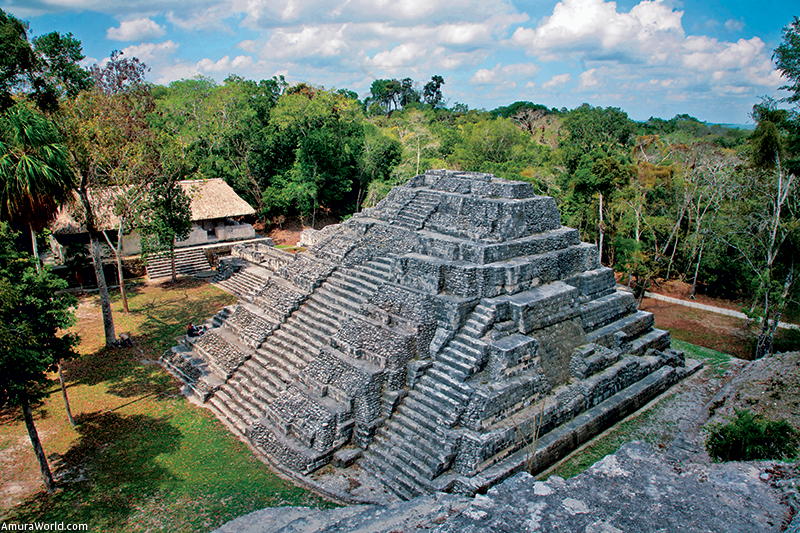An adventure with Mayan heart
From mountains to volcanoes, from lakes to coasts and from jungles to rivers, Guatemala received us as a land of adventure and culture, of sports and hikes. Everything surprises us, the faces of the people so intriguing and illuminated by glances filled with history, the beauty of various textiles gleaming from marketplaces, and the fire of the volcanoes warms up the clouds that moisten the earth. It is a country with a rich Mayan history that treats visitors with kindness, offering its treasures for them to be enjoyed.
Navigating from the Caribbean coast of Mexico, following the second largest corral reef in the world, we passed Belize and Honduras until we reached Puerto Barrios, where we found lively streets and active port on the shores of the immense mangrove. The wooden constructions remind one of the British colonial architecture, and the tropical environment is animated by people of all races. We travelled through a highway that would lead us to the heart of the country, visiting the Mayan ruins in Quiriguá, which boasts the most beautiful of wakes that represent the nobility and whose hieroglyphics speak of a place that has seen settlements since the year 400 a.C., being an enemy of Copán.
We arrived at an important intersection in Tulumaje were we had breakfast at the renowned Sarita restaurant to make our way into the mountains, yet not before stopping at the quetzal “biotope”, near Salamá, in Baja Verapaz, which bears the name of Mario Dary Rivera, the man who founded the place in 1976. It is a nebulous forest 1,000 hectares in size, cuddled between hills and valleys of the Sierra de las Minas. His goal is the conservation of the habitat for the Quetzals, and it is one of the most superb spots to observe this majestic bird whose feathers adorned the crowns of Mayan rulers. From there we travelled through the paths that allowed us to witness the slopes, waterfalls, orchids, bromeliads, and other treasures of a habitat springing with biodiversity.
We became acquainted with squirrels, two foxes, and various species of monkeys that live at the very top of the trees and, finally, we admired a pair of quetzals eating fruit. They were beautiful, the male showcasing its long tail who’s green and red colors gleamed like precious stones when the sun casted its light on them.
Nature whims
We reached the city of Cobán, nestled between the Alta Verapaz mountains, and we visited the impressive home of the Archila family, where we observed a variety of orchids, like the Licastes, the national flower of Guatemala, as well as cattleyas, laelias and various other species. It was a grand spectacle, indeed. In the church of Cobán, the people would enter to pray; saints waiting to listen to their lamentations or grateful thoughts, the women wearing the traditional white, boarded huipiles which falls over their short blue skirts. They carried their colourful mantle, and displayed their braided hair interlaced with strips of red cloth which would be then tied up at the end. We then made our way through the ridges of the mountains, driving down a dirt road inside a spectacular narrow valley peppered with trees, where the depth of the pools astounds one with a symphony of colors, sounds and the penetrating odours of the jungle. This led us to Lanquín, a caprice of nature where crystalline, emerald-colored waters spring from the mountain, a fairy tale refuge in the midst of dense vegetation accompanied by whispers created by the movement of the water. Inside this rock we discovered the magnificence of the ridges heavily damaged by erosion. A somewhat slippery path led us unto monumental open spaces, accompanied by our q’echí guide who knew every single detail of this cathedral made of rock. At six in the afternoon, thousands of bats fly out of their crevices and do not return until five-thirty in the morning, and not before enjoying a feast of agapes.
The river runs through a deep canyon and we followed it until we reached the rustic El Recreo hotel, in the midst of the jungle, although we kept on travelling, passing through the colourful town of Lanquín, which is dominated by its church, and through the same path that took us to the Cahabón river, a place were a few tourist would throw themselves into the water from the top of a large rock, locals watching nearby. Walking upstream, we reached the beautiful puddles of Semuc Champey, where the river travels through a narrow canyon, diversifying itself in ponds of jade colours and small waterfalls that animate the rocks covered with mineral deposits, offering an exceptional panorama. We explored the intriguing sounds, observing the orchids and the bromeliads, until we arrived at the viewpoint where one can observe the emerald ponds on the deepest parts of the precipice. It was a spectacular scenery, the vegetation created a lavish frame for that emerald river divided in strange forms by the rocks. After walking downstream through the jungle we bathed in the ponds, enjoying the fresh water. It was a moment saturated in mysticism and the smell of paradise, observing the birds and the butterflies. When the sun began to set behind the mountains, we returned to the hotel to enjoy dinner and mysterious sounds created by the jungle at night.
Early next morning, inside the same double traction vehicle, we drove down a road that bordered the Cahabón river until we arrived to the small town which held all of the equipment that would take us rafting. A peaceful town by the water where the boats were waiting for us. We began to navigate through the currents, discovering the sumptuous landscape, alone inside the jungle adorned with mountains. Some rapids welcomed us with a good pace, and a sense of playful danger; the boat would rise and drop with force, tormented by the flow of the river and fighting with the rocks that were created by those white waters full of vortexes. The adrenaline rose, excitement invaded us, completely enthralled inside the magnificent scenery. Finally, after many incidents on the river, we reached the hanging bridge and the vehicle that waited for us on the shore. We peacefully made our way back to Cobán to continue our travels through the jungle and mountains up towards the valley.
History and tradition
Once settled inside the luxurious Vista Real hotel that dominates one of the various hills and ridges of this Guatemalan city, we enjoyed the Spa and the pool, visited the historic center – home to the Government palace, and the cathedral that adorns the immense plaza – the Popol Vuh museum to admire the surprising Mayan cups adorns with scenes from that glorious epoch of great reigns, as well as the Francisco Marroquín university, the anthropological museum, the interesting railroad museum where we discovered wagons and steam-engines from times long past accompanied by a guide who compelled us to relive historic times. We also admired the relief map that depicts the entire country: mountains, lakes coasts and steep ridges where the rivers take one all the way down to the Petén plain. It is an impressive work from the early 20th century, and it was built by the engineer Fancisco Vela. It shows one the exact scale of the volcanoes, rivers and lakes. When then had a meal at the local kacao restaurant to try food that is quite representative of the country. We enjoyed the enchanting Miraflores museum which tells the story of the area that was once a lake adorned with pyramids from the city of Kaminal Juyu, a place settled by fishermen of yore.
Taking the highway that infiltrates the mountains, we stopped for breakfast at the famous Kapé Paulino’s restaurant, built on the side of the highway, at the edge of a pine tree forest, which serves the most exquisite chorizos, hams, and huevos rancheros. Finally, we arrived at Chichicastenango, at 1, 965 meters above sea level that mythical hidden town inside the Quiché mountain region. We arrived the day the market was blooming, and the town was lit up by the colors of the “huipiles” that the women wore; one would tumble and grow dizzy while walking through the crowds and the food, clothe, arts and mask stands. At the stairs of the white church of Santo Tomás, men dressed in traditional animal or human costumes burned copal, filling the air with smoke; the women sold flowers and would invite one to admire the many varieties they offered, while strange ceremonies were being held not far away: cleansings, healings and bewitchments. Inside the church, incense filled the air, while the people would quietly pray on their knees near candles that melted down to the floor, while the saints carried their clothes while they waited to hear the words of the faithful. It was a mysterious atmosphere – intriguing and impressive – that made one feel as if inside a Mayan ceremony at the peak of its glory. The church is built atop a pre-Hispanic temple, and the stairs le done towards the temple, each of its 18 steps representing a month of the Mayan Calendar.
The plaza is a vortex, and we travelled through its alleyways, travelling down towards the edge of the town to climb a hill, visiting San Pascual Abajo whose brotherhood guards the sanctuary, organizing ceremonies at the top of the hill where the copal disperses its fragrance throughout the woods. The walk towards the top of the hill was intense due to the thin air and the altitude, but well worth it to experience a thunder of the past. We dined at the enchanting Posada Santo Tomás, to the rhythm of marimba, admiring the beautiful guacamayas that animated the patio.
We continued to travel until we arrived that the viewpoint that dominates the gorgeous Atitlán lake, surrounded by volcanoes: the Atitlán volcano, 3,357 meters high, the Tolimán, 3,150 meters, and the San Pedro volcano, at 3,020 meters, while the lake itself is situated 1,560 meters above sea level, spanning 18 km in length, and boasting a maximum depth of 350 meters. The scenery is majestic, impressive, with the imposing mountains that enclose it and a place that many an indigenous culture, each with its own unique traits, calls, “home”. Afterwards, we arrived at Panajachel to settle at the exquisite Atitlán Hotel, which boasts a blooming tropical jungle gardens that reaches down to the lake, and which is the home of various air is also and land species. It also features a pool whose surface is lost amongst the immensity of the lake. We walked down towards the dock to board a small vessel and enjoy the unsettling Xocomil, a strong gust of wind that is produced at noon, when the warm winds of the south clash with the mass of cold air coming in from the steppe. The wind vortex drove us, and it was difficult to stay in control of the vessel; the ship would wobble, the adrenaline in our bodies rose, fear overtook us and we were not to accomplish this impossible feat. We pulled the sails down and returned to Panajachel, walking around the dock, and admiring the great variety of crafts and the church that was built right after the Tzutuhiles were conquered. It features a beautiful façade that is considered a jewel of the colonial style. The ambience inside Panajachel is created by its bars, restaurants, travellers from around the world, and the general glee found on the faces of the indigenous people.
Weaving the loom
At sunrise, the look took the form of a mirror, the sun began to shine, and the water assumed a jade coloration with a crystalline transparency. Soon after, we left the hotel dock in our boat to travel along the coast until we arrived to the town of San Juan la Laguna. The streets here were impeccably clean, the mayor welcomed us to peacefully visit this town that seem to have been frozen in time. We met the painter Antonio Vásquez who has created a unique style and we visited other painters exposing their works, some who have decorated numerous facades, giving the town a vanguard appearance entwined with a past rich in creative energy. We walked through the workshops were women would dye clothing, another were medicinal plants were grown, another which served as an art studio, each one receiving us with the kindness that characterises the locals. San Juan is a place of peace and enlighten.
We stopped at San Pedro to unravel a different World, one that features a white church at the end the top of the stairs. The alleyways rattle with the sounds coming out of restaurants, and there exists a great variety of “posadas” where tourists arrive to encounter an original town where the Mayan world and the tourist mingle.
From there we arrived, after walking around the San Pedro volcano, to the deep cove lodged between two volcanoes, and where the town of Santiago Atlitán lies hidden. It’s people, the Tuzutuhil, worship the cult of Maximón, a local idol who is product of the fusion between Mayan culture and Christianity. The effigy is made of wood and adorned with a straw hat and is found under the custody of a local, religious brotherhood and then kept in various homes throughout the year and moved to another home in the midst of a great ceremony. We visited one of these houses, the people sitting close the effigy, drinking beer, smoking, conversing, praying and singing while surrounded by candles and incense. Maximón would have a lit cigarette placed in his mouth while a young couple asked for his blessing, their faces mingling with the faces of saints that also filled the room. I felt as if I was travelling backwards in time, absorbed by a mysterious fourth dimension that dragged me through space. Inside the church, the saints received prayers and lamentations alongside the smoke coming from the burned copal
We continued our journey by crossing the lake, the Xocomil has already risen and the waves became larger and more frequent, vibrating the boat until we reached Santa Catarina Palopó, where we were greeted at the dock by women dressed in turquoise-colored dresses and a black skirt knitted by hand, as well as men wearing embroidered pants. The church, built in 1726, boasts a beautiful bell-tower, the people are friendly, the town is peaceful, and we enjoyed excellent food at the Villa Santa Catarina restaurant, built on the shore.
Vestiges and volcanoes
We continued our journey by car, driving along the mountains that surround the lake, through the forests, and through various towns forgotten by time until we could reach the high plain where I discovered the impressive church of Patzún , built buy Franciscan missionaries in 1540, and which harbors the image of Bernardino, patron of the town situated 2,213 meters above sea level, The people belong to the Cakchikel ethnic group, and the color red dominates their embroidered clothing marvellously. The church boasts a white façade, and whose interior astounds one with its mudejar ceiling.
Finally, we drove down the valley to reach the city of Antigua. We stayed at the sumptuous Porta Hotel Antigua which once was one of the most important residences of the city. Santiago de los Caballeros de Guatemala was the original name of the city, founded on 25th of July, 1554, by Don Pedro de Alvarado, sent by Cortez from Mexico, a place where the capital city of Cakchikel once stood. After various earthquakes and floods, the city was moved to the Panchoy valley where we had the opportunity to visit its elegant streets, churches and palaces. Given that the city is located in the middle of three tectonic plates, earthquakes would rattle the churches often, and it was decided to move the capital city to the Ermita valley in 1774 – what was once know as La Antigua being abandoned by its inhabitants.
It is enclosed by the Acatenango, Water, and Fire volcanoes, the last which can display violent activity , spewing ash, rock and lava frequently, and, finally, the Pacaya volcano that is also slightly active and also spews lava and ash. We walked through the streets to discover the enchantments of city, a place where the ruins provide it with a romantic air. Next to the hotel we discovered the ruins of San Jose el Viejo featuring a baroque façade built strong enough to withstand earthquakes. Reaching the Central Plaza, we admired the imposing university building, boasting an elegant door, as well as a mudejar style. It is home to an impressive colonial art collection that features sober paintings and polychromatic sculptures. The cathedral dominates the Plaza, an imposing building the size of a city block and who has seen its fare share of disasters. It was built in 1670. We walked afterwards through the Arco street, dotted with luxurious houses. The yellow arc found in Don Rodrigo’s house was built to bridge the gap between the two parts of the Santa Catalina monastery and it provides the street with an intimate touch. From there, we reached La Merced convent, with its fabulous white and yellow baroque façade framed by two bell-towers and adorned with sculptures, in front of the atriums cross. The monastery was immense and one can still appreciate the principal patio that is home to the largest fountain in the city, flanked by cherubs.
Walking through these streets, we discovered elegant colonial houses, and we visited the most prominent religious monuments: the temple of Saint Theresa which only the façade remains, the Capuchin convent with its imposing church and monastery, the temple of Carmen whose ruins feature a richly adorned baroque façade and the temple of Saint Peter. We then reached the small park adorned by the La Union temple, which was one of the ancient bathing houses covered with beautiful arch’s that reflect on the water. In front of it one finds the Santa Clara monastery, a two-level church that was, and is, monumental, even in ruins, and we could appreciate the two facades of the church displaying various images of saints. Adjacent to it we discovered San Francis the Great, which is still in service, featuring a richly adorned door and opulent colonial area chapels. Its cloister is imposing by its beauty and in one of the chapels one can find the tom of Brother Pedro, a highly venerated man. Along the walls of the monastery, we found the Via Crucis station, and the street takes one to the church of the calvary, a small, simple and baroque church. We walked through the La Paz gardens, surrounded by the temple La Escuela de Cristo and the convent of Belen, founded by Brother Pedro. We finished our tour Santa Cruz hermitage, at the foot of the hill, drowned in vegetation. Antigua is a living world in the midst of the ruins of the church and monumental monasteries, where the flavors of yore plays with the life of a city that vibrates at the tune of its bars, restaurants, markets and authentic folklore.
Leaving the city, we passed through mounts and towns and began our ascension towards the Pacaya volcano until we reached by car the small village of San Francisco de Sales. We rode on horses, travelling through the jungle, until we reached the Chiquito mount where we discovered lava. We left the horses in place to keep walking upwards, on top of twisted, solid lava, observing the Mackenney top whose main crater is found 2,252 meters above sea level, and from where smoke is spewed day and night. We discovered a place where one could see this incandescent lava and, touching it with a stick, see it burst into flames. Back in the capital, we settled at the Grand Tikal Futura, a luxurious modern building located nearby the commercial area, which boasts rather fine restaurants.
Unforgettable adventure
Early next morning, we took the flight that would take us to Flores, now staying at the Villa Maya hotel, in the heart of the jungle, and right next to the lake, observing caimans and monkeys. We then made our way to the Tikal National Park, an ecological reserve in which impressive pyramids rise between the jungle trees. Walking through the dirt roads, we explored each and every one of the pyramids which would then open up to a plaza enclosed by palaces. We climbed the wooden steps up to the top of these pyramids that dominate the jungle skyline and admired the various species of birds that could be observed from these points. It is still an astounding city that has risen from its ruins to marvel the modern world.
The next day, we once again made our way back, travelling through farmlands that were once part of the jungle, towns and rivers and we found our boat at the foot of the bridge that crosses the Dulce river. We navigated through the lake and went out to sea to discover the lovely Livingston island, its crystal clear waters glistening under the sun, dotted with white sands, until we made it to the road that would take us to Honduras to discover new adventures and explore the Copán ruins.
Guatemala is a Mayan land, a country of adventures in the midst of a rich past that survives inside its markets where the “huipiles” explode with color, where the faces of the people speak of times when the pyramids guard the future, and where the lakes reflects a sky that has seen much history unfold. We have discovered adventure, sumptuous landscapes, the perils of rafting and the blazing lava, the blessings of Maximón and the fury of the Xocomil; we have fell in love with the colorfulness of this exceptional place that beats between a fabulous past and a colourful present. Guatemala is in itself an authentic adventure.
Text: Patrick Monney ± Photo: Patrick Monney, Getty images, cortesía de INGUAT, STOCK.SC


